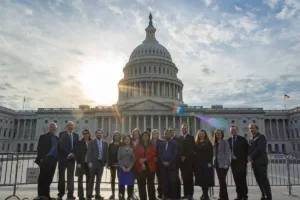For over 50 years, the Universities Research Association has engaged in laboratory management and continues to contribute to the national science enterprise through management and operating (M&O) contracts with the Department of Energy. Today, URA participates in key partnerships and M&O contracts which include the Fermi Research Alliance, National Technology and Engineering Solutions of Sandia (NTESS), and the National Science Foundation.
 Early History
Early History
The Universities Research Association (URA) was founded in 1965 by a cohort of 34 universities across the U.S. to “provide a national basis” for the management and operation of the proposed 200 GeV proton accelerator. This project emerged from recommendations on behalf of the scientific community to expand the frontiers of high-energy physics research. Norman Ramsey, who later became URA’s first president, directed a joint panel in 1963 of the President’s Science Advisory Committee and the General Advisory Committee of the Atomic Energy Commission. This panel recommended the construction of a proton accelerator. The panel also emphasized the importance of national representation for the accelerator and an administrative structure that encompassed national interests.
Following the panel’s recommendation, designs for the accelerator were initiated by Lawrence Radiation Laboratory and completed in 1965. Next, the Atomic Energy Commission began its twenty-month-long search for a laboratory site to house the accelerator. The Atomic Energy Commission received 126 proposals suggesting almost 200 site locations in 46 different states. In 1966, the AEC selected 6,800 acres in Weston, Illinois, for the project.
It was suggested that a “truly national laboratory” would house the accelerator, later referred to as the Tevatron, to promote equal consideration of experiments and access to its users based on scientific merit. These needs laid the foundation for the Universities Research Association and the creation of Fermi National Accelerator Laboratory.
Fermilab and the Tevatron
Fermilab was home to the Tevatron which operated from 1983 until 2011. It was the first particle accelerator to reach energies up to 1TeV — hence its name— the Tevatron enabled the discovery of the Top Quark, the most massive of the Standard Model fermions. Since the shutdown of the Tevatron in 2011, experiments using particle beams produced in Fermilab’s accelerators continue to explore the fundamental nature of matter, energy, space, and time, and their relationships in the physical universe.
Fermilab and the Large Hadron Collider (LHC)
The next generation on the energy frontier began with the initiation of the Large Hadron Collider (LHC) at the CERN facility outside of Geneva, Switzerland, now the world’s high-energy accelerator for elementary particle physics research. Fermilab was a full partner in the construction of the LHC that announced the discovery of the long-sought Higgs Boson in 2012, which was previously hinted at in final Tevatron data. Today, the LHC Remote Operations Center at Fermilab keeps U.S. scientists and technicians closely connected to activities at the LHC and Fermilab continues to participate in the upgrade of the LHC’s capabilities.
URA Today
Today, as a consortium of over 94 academic institutions across the United States, Japan, Canada, and Italy. URA aims to pair the academic expertise of its members with national laboratories to foster scientific innovation. For over 50 years, URA has operated in the national interest by generating a STEM talent pipeline to associated laboratories; promoting university-laboratory partnerships; and communicating the needs of academic institutions and laboratories to key science policymakers. URA’s partnering laboratories currently include Fermi National Accelerator Laboratory, Sandia National Laboratories, and Pierre Auger Observatory.







 Early History
Early History